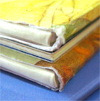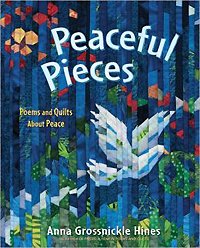|
|
|
|
|
|
|

| 최근 이 책을 구매하신 다른 회원의 책장 |
|
 |
|
|
|
[ 책 소개 ]
* Jane Addams Children's Book Award Winner
* Indiana Young Hoosier Award Master List
* Ohio Choose to Read Program
평화를 주제로 주옥과 같은 동시 28편이 아름다운 그림들과 함께 실려 있는 책입니다. 특히 각각의 시의 내용을 보여주는 그림들은 조각천들을 이용해서 수작업으로 직접 만든 패치워크 퀼트작품들이어서 감상할만한 가치가 있습니다. 작가 안나 그로스니클 하인즈는 전쟁과 반대되는 개념의 평화뿐만 아니라, 물과 돌, 잔잔한 호수, 우리의 내면, 인간 관계, 우리가 사는 곳, 소음 속의 정적 등 다양한 형태의 "평화"를 탐구합니다. 평화의 의미와 속성, 그리고 평화를 추구하는 행동들의 중요성을 깨닫게 해줍니다.
큰 사이즈의 튼튼한 | 닫기x |  What is 하드커버? What is 하드커버?
양장본이라고도 불리우며, 표지가 단단한 판지로 만들어진 책입니다.
판지를 천이나 가죽으로 감싸기도 합니다. 책의 속지는 일반적으로 중성처리된 종이(Acid-free paper)를 사용해서 잘 변질이 되지 않기 때문에 오랫동안 보관하기에 적합합니다. 이 종류의 책은 더스트 재킷, 또는 더스트 커버로 불리는 표지덮개가 함께 있는 경우가 많습니다. 간혹 내부 속지가 콩기름 코팅이 된 경우 고약한 냄새가 나는 책도 있습니다.
|
[ 관련 동영상 보기 ]
 ▶
[ 서지 정보 ]
Hardcover: 32 pages
ISBN-10: 0805089969
ISBN-13: 978-0805089967
책 크기: 28.6 cm x 24.7 cm
[ 영문 서평 ]
Book Description
In this evocative collection of poems illustrated by beautiful handmade quilts, Anna Grossnickle Hines explores peace in all its various and sometimes surprising forms: from peace at home to peace on a worldwide scale to peace within oneself. Pondering the meaning of peace and its fleeting nature, this book compels each of us to discover and act upon peace ourselves.
School Library Journal
Using exquisitely detailed handmade quilts as a backdrop, Hines's poems explore the overarching themes of peace, understanding, tolerance, and friendship. The diverse selections illustrate the ways in which peace relates to everyday life and are presented in a variety of formats and contexts. For example, one poem is told from the perspective of a child whose father came back from war a changed man. Another uses the game of dominoes as a metaphor for the idea that human beings influence one another in far-reaching ways. The quilts that accompany the selections serve to expand upon their themes and create an interesting contrast to the text. Children will be fascinated by the painstakingly intricate stitching, bold colors, and poignant imagery. In an author's note, Hines describes her writing and quilt-making processes. Mini-biographies of eight influential peacemakers, including Mother Teresa and Gandhi, are included. This book would be perfect for reading aloud and also appropriate for independent reading by poetry-loving children. Because of its unique presentation and breadth of subjects, Peaceful Pieces would be a good companion to Vladimir Radunsky's What Does Peace Feel Like? (S & S, 2004). While some of the poems are more moving than others, the collection as a whole underscores the importance of people finding common ground despite their differences.
From Booklist *Starred Review*
In Pieces: A Year in Poems & Quilts (2001), Hines took her books in a new direction, creating quilts to illustrate poems written around a central theme. Her newest jewel-bright offering showcases 28 short poems about peace, a broad concept interpreted here in varied ways. The narrative poems wind their way to the central point, while the haiku and acrostics are brief and pithy. The most effective pieces are the most specific and personal, even when their connection to peace seems, at first, oblique. Several poems interpret the theme in ways that speak directly to a child’s experience, while others reflect a broader view. The most striking aspect of the book is its quilted, pieced-cloth artwork, and the borderless pages allow maximum impact for Hines’ bold, expressive visual statements. Two of the spreads are composed mainly in black and white, while, in others, colors, patterns, and stitched lines create a rich variety of effects, from scenes evoking a surprising illusion of depth to bold images that seem to rise from their backgrounds. In the closing pages, Hines comments on the process of quilting and identifies the eight peacemakers photographically represented in one of the illustrations. A beautiful poetry book on an ever-relevant theme.
|
|
|
|
|
|
|
|
|